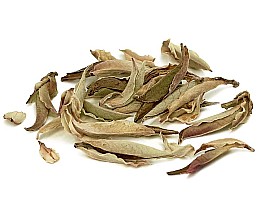2023 Thai Giant (1300 y.o.) Single Tree Wild Tea Loose-leaf, Oolong Style
This wild tea is collected from probably the oldest tree in Thailand. The estimated age is 1300-1500 years. The tree has already begun to crumble, it is difficult to say how many more years it will stand.
The leaf is harvested to order by members of the Lahu tribe who live in the jungle, in small villages. Getting such material and processing it so competently is a great success for a little local farm. They made the tea in oolong style and it was an excellent technological choice.
Warmed up, it gives off a powerful caramel-fruity aroma.
The taste is clean, crisp, dense, full-bodied, and balanced. Smooth and soft on the throat, without excess acidity. Drinks wonderfully. You can steep it endlessly.
The aftertaste is caramel-floral, moderately long.
In general, wild varieties are not as oily as cultivars and hybrids. A good marker is the stability of the foam of the infusion. In wild teas, the foam almost does not hold. Cultivated varieties of old trees grown on fertile land can keep foam indefinitely.
Nevertheless, one can observe a very long aftertaste in our Giant — probably the longest for a wild tea.
And in terms of the beauty of the palette, this material will not yield to anyone. Subtle, sensual floral, and fruity tones of nature itself. I'm at a loss for words, try it yourself and give us feedback.
The Qi effect. Don't expect a hit on the head, this is not about wild tea. But if you are experienced enough, then by the middle of the session, you will definitely find yourself calmed and cleansed. This is about our wild tea from a giant tree.
Reviews (7)
This is one of the most interesting teas from my recent order with tea-side, being assamica (or adjacent) material processed as Oolong. This was the last of my sample.
Texturally, this tea feels like a young sheng. It is sweet in a similar manner. It, however, lacks any astringency or bitterness akin to young sheng, even if pushed very hard.
It seems to processed adjacent to a Dancong, but can stand up to far harder steeping without even a hint of flaw - 12g/600ml or so, which produces a pretty unpalatable astringent soup with standard Dancongs. It doesn't have any acidity as you might get from a high roast tea, also. It's quite delicious, and well suited to both high and low ratio brewing. It has decent longevity, too, and a nice calming effect alongside a strong sheng-like floral aftertaste. I enjoyed this session a lot.
This oolong is one of a kind! Nothing like what I had! I love the Cha qi! For this one the Cha qi is similar to 2016 Wild Pu-erh Tea “Lord of the Forest” 1000-year-old trees Myanmar. Its Cha qi is even stronger than some of my aged old tree pu-erh. Flavor wise it's fruity and floral, a little mild, elegant.. and actually I think this tea tasted like a combination Junshan silver needles, sheng pu-erh and ruan zhi oolong.
I've tasted this a while ago, and I remember it to be mostly fruity (couldn't find my notes).
And the way I brewed it a second time, more recently, it was noticeably more floral (wild flowers and a bit of rose), also honey, caramel, and a bit of pumpernickel.
It is pleasant to drink, and the reason I am not giving it maximum rating is because it's a bit too mild for me.
I liked the tea very much extremely unusual. It is difficult to describe the exact taste sensations, but the palette subjectively gravitated towards fruits (conditionally peach or apricot), dried fruits (apricots) and a little bit like dried mushrooms in the smell of dry tea (like chanterelles). It is very conditional because it was difficult to "catch" the associations, but I liked the tea very much - it was not like anything else and the flavor was very "voluminous". The state from it is a little "drunk", but pleasant.
When brewing in a teapot, the tea was a little lost - became similar in taste and aroma to shen puer. That is, it was still tasty and pleasant, but all its richness was better revealed in the gaiwan.
The tea is extremely good, deep and interesting, but not for every day).
“Old trees, wild trees.” That’s something Treebeard the Ent says in Lord of the Rings. And it’s what excited me about trying this wild tea along with the other wild teas. Giant is similar to Purple Joy but milder. The flavor profile shares a fruitiness and acidic notes that develop more strongly with the second cup, but Giant Single Tree is just less weird. Would definitely have this again.












